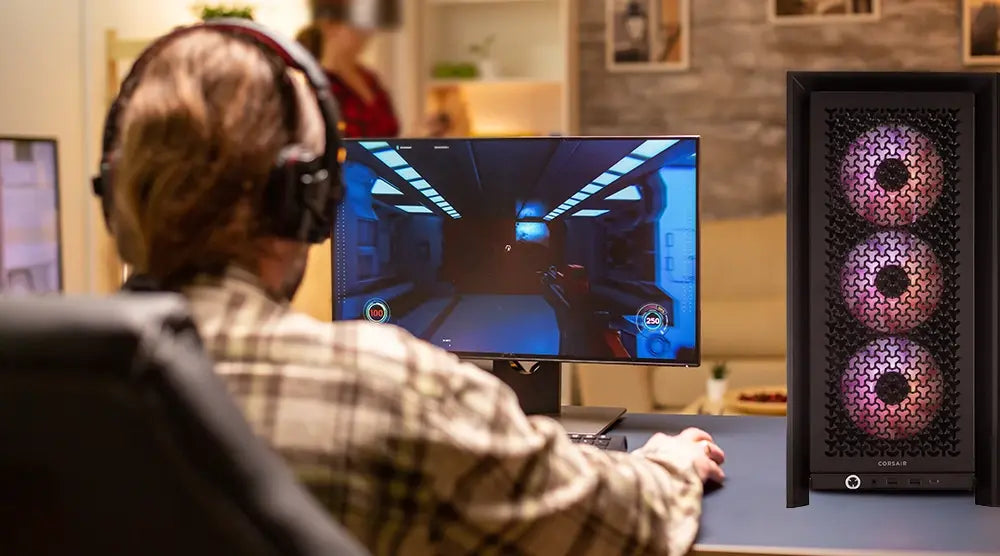Every frame is important in competitive esports. Higher frames per second (FPS) can mean the difference between landing the perfect headshot and missing entirely. Good quality gaming translates to faster reaction times, less input lag, and so more wins. Knowing how to increase FPS is vital whether you're a casual player starting ranked matches or an ambitious pro trying to maximize your chances of success.
This blog will explain why FPS is crucial in esports and how to increase FPS through software tweaks, hardware upgrades, and pro-level optimization techniques.
Why FPS is Essential in Esports
FPS, or frames per second, counts how many frames your PC can create every second. The more frames per second (FPS), the smoother the gameplay.
Effects on Competitive Gaming
- 60 FPS: Playable, but often too slow for competitive esports.
- 120 FPS: Noticeably smoother visuals and improved input response.
- 144 FPS: The current benchmark for most esports competitions.
- 240+ FPS: Ultra-smooth performance for serious competitors, enabling faster reactions.
Because even a single dropped frame can cause issues or delay reactions, leading to costly mistakes in high-stakes competitions, professional esports players depend on steady, high frames per second.
Software Tweaks to Improve FPS: Quick Fixes
Start with these free or low-effort optimizations before considering a hardware upgrade:
Drivers:
- Maintain Windows upgrades and current NVIDIA/AMD GPU drivers.
- If your drivers are not updated, it sometimes causes performance bottlenecks.
Close Background Applications:
- Kill pointless programs (Discord overlays, Chrome tabs, etc.) using Task Manager.
- Enable Windows' Game Mode for better resource distribution.
Enhancement of In-Game Settings:
- Reduce or disable anti-aliasing, reflections, and shadows.
- Set textures to medium for a balance between visuals and performance.
- If needed, lower resolution scaling to improve FPS.
Change resolution
If FPS is low, run games at 1080p rather than 1440p/4K for smoother frames.
Hardware Upgrades to Increase FPS
If software tweaks aren’t enough, you can significantly boost FPS by upgrading your hardware:
1. GPU (Graphics Card)
- The GPU is the most important component for FPS.
- Modern esports players should consider upgrading from a GTX 1660 to an RTX 3060 or higher.
- For competitive gaming, prioritize raw FPS over graphics features like ray tracing.
2. Processing Unit
- Combine a powerful CPU with your GPU to prevent bottlenecks.
- The suggested brands are Intel i5/i7 or AMD Ryzen 5/7 series.
- In CPU-heavy games like CS2 or Valorant, the CPU affects frame stability.
3. Random Access Memory
- 16GB is the standard for esports.
- 32GB is ideal for multitasking and streaming.
Pro-Level FPS Optimization
Best Refresh Rate Monitors
- 144Hz: Basic competition level.
- 240Hz/ 360Hz: Preferred for pro players.
CPU/GPU Overclocking
- Safely increase clock speeds to boost FPS using software like MSI Afterburner.
- Always monitor temperatures to prevent overheating.
Esports-Optimized Game Settings
- Valorant has a high refresh rate with low shadows and moderate textures.
- In CS2, motion blur should be turned off; textures and models should be lowered.
- In Fortnite, set low view distance and enable Performance Mode to improve FPS and gameplay smoothness.
Many esports players use an esports-optimized gaming computer for plug-and-play peak performance.
When It’s Time to Upgrade Your Rig
You've tried upgraded components, tuned settings, and software tweaks, yet FPS still falls behind. That is when a complete system update becomes essential.
Signs Your System Is Holding Back FPS
- In esports titles, FPS drops frequently below 60.
- Stutters in competitive matches.
- Performance bottlenecks in the CPU or in an old GPU (5+ years).
Advantages of a Prebuilt Esports-Optimized Gaming Computer
- Designed specifically for esports, with systems optimized for high FPS.
- Pre-configured settings for peak performance right out of the box.
- Tested for stability in popular titles like Apex Legends, Valorant, and CS2.
- Comes with a warranty and support, providing peace of mind for gamers.
Future-Proofing
- Greater bandwidth from DDR5 memory.
- PCIe 5.0 SSDs for incredible loading times.
- Future GPUs to lead the curve.
Final Thoughts
Knowing how to increase FPS is essential for esports players who want smoother gameplay, faster reactions, and a competitive edge.
From software tweaks to hardware upgrades and pro-level optimizations, every adjustment counts. For those seeking consistent high FPS without building a rig from scratch, Technoid Inc. offers prebuilt esports-optimized gaming computers designed for peak performance, tested stability, and reliable support.
Visit our store today to boost your FPS and maximize your winning chances!
People May Ask
1. What perfect frame rate is for esports?
Most competitive players aim for 144 FPS or higher, while 240 FPS is ideal if your system allows.
2. Will FPS be increased by RAM upgrade?
Going from 8GB to 16GB represents a big improvement. Beyond 16GB, benefits are little unless multitasking or streaming.
3. Is overclocking riskless?
Yes, if done slowly and with adequate cooling. Measure stability and temperatures constantly.
4. Should I build my own or get a prebuilt esports computer?
A prebuilt esports-optimized gaming PC offers tested performance, convenience, and reliable support, though it may cost more. Building your own can save money but requires technical knowledge and time.

 United States
United States

